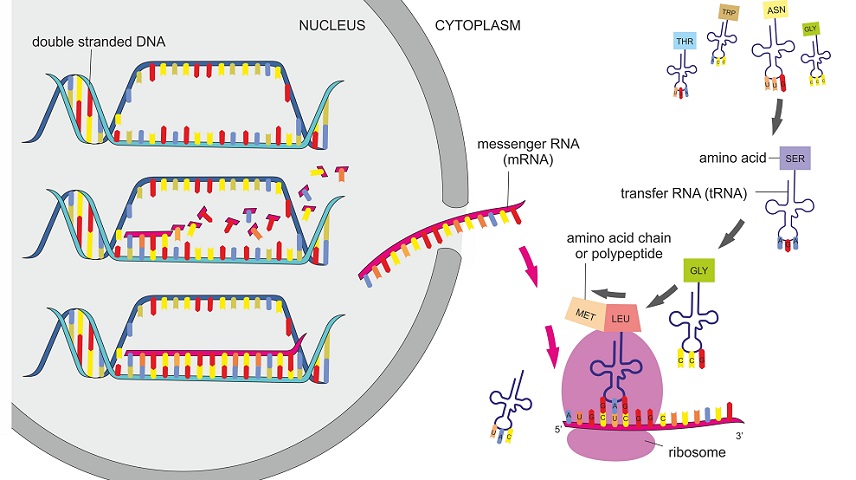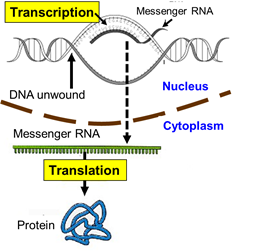Describe Protein Synthesis Using Transcription and Translation
DNA is a triplet. During transcription DNA partially unwinds by the enzyme helicase.

Protein Synthesis The Definitive Guide Biology Dictionary
Follows the same base-pairing rules of DNA except that in RNA Uracil replaces Thymine.

. Arguably the most widely used cell free technology is cell free protein synthesis CFPS an in vitro platform for protein transcription TX and translation TL. Transcription The process of producing an mRNA template from a DNA molecule is termed transcription. During translation the mRNA works with a ribosome and tRNA to synthesize proteins.
For the creation of a new generation the genetic information stored in the DNA has to be transferred from one generation to another. The process of translation or protein synthesis the second part of gene expression involves the decoding by a ribosome of an mRNA message into a polypeptide product. Describe the structure and potential products of a gene polypeptide rRNA tRNA mRNA and the types of proteins required for transcription RNA polymerases transcription factors etc.
The process of translation or protein synthesis the second part of gene expression involves the decoding by a ribosome of an mRNA message into a polypeptide product. Describe the flow of information through cells the central dogma and the cell components that participate. In both bacteria and archaea before transcriptional termination occurs each protein-encoding transcript is already being used to begin synthesis of numerous copies of the encoded polypeptides because the processes of transcription and translation can occur concurrently forming polyribosomes Figure 2.
Catalyzed from RNA polymerase which pries the DNA strand apart and hooks together the RNA nucleotides. Describe the role of polymerase in transcription. Describe Process of Protein Synthesis.
This copy called a messenger RNA mRNA molecule leaves the cell nucleus and enters the cytoplasm where it directs the synthesis of the protein which it encodes. They are transcription and translation. This is a two-step process.
The reason why transcription and translation can occur. The protein synthesis occurs in two steps namely transcription and translation. Transcription is the first step of protein synthesis.
It is the second part of the central dogma in genetics. After mRNA has been made it leaves the nucleus and goes to the ribosomes in the cytoplasm where translation occurs. Protein Synthesis in the Cell and the Central Dogma Protein is necessary for healthy cells.
The reason why transcription and translation can occur. Learn about the roles of central dogma and protein synthesis in the process to form protein molecules. During translation the mRNA works with a ribosome and tRNA to synthesize proteins.
In both bacteria and archaea before transcriptional termination occurs each protein-encoding transcript is already being used to begin synthesis of numerous copies of the encoded polypeptides because the processes of transcription and translation can occur concurrently forming polyribosomes Figure 2. The synthesis of proteins takes two steps. During transcription mRNA Messenger RNA is formed in the nucleus of the cell.
Proteins are important organic compounds present in living organisms. Transcription and translation the processes by which information stored in DNA is converted to a working protein are at the center of metabolism and signal transduction programs. Protein Synthesis is a process of synthesizing proteins in a chain of amino acids known as polypeptides.
Explain the processes necessary for transcription to begin. Recognize that protein synthesis regulation ie changes in gene expression allow cells to respond to changes in the environment. Here is a more complete definition of translation.
Cell uses the genes to synthesize proteins. Translation the process whereby genetic information coded in messenger RNA directs the formation of a specific protein at a ribosome in the cytoplasm Polypeptide Chain A protein molecule formed during translation. Explain how DNA is transcribed to create an mRNA sequence.
Protein synthesis consists of two stages transcription and translation. The Genetic Code Translation of the mRNA template converts nucleotide-based genetic information into the language of amino acids to create a protein product. The process in which DNA is copied is called 12 replication.
It takes place in the ribosomes found in the cytosol or those attached to the rough endoplasmic reticulum. Initiation Elongation and Termination. Transcription takes the information that is coded in DNA and codes it into mRNA which heads out of the cells nucleus and into the cytoplasm.
Protein synthesis or protein biosynthesis is a process by which cells create new proteins in order to replace those lost through degeneration and transportation. The second step is. Protein synthesis refers to the construction of proteins by the living cells.
The Genetic Code Translation of the mRNA template converts nucleotide-based genetic information into the language of amino acids to create a protein product. Transcription completes in four major steps- 1 Initiation 2 Promoter Escape. In transcription the DNA code is read and in translation the code is used to build up protein molecules.
During transcription the information from DNA is encoded into mRNA. Protein Synthesis The central dogma describes how the DNA makes its own copies by DNA replication then codes for the RNA by means of a transcription and RNA codes for the proteins by translation. A long series of Amino Acids linked together by.
Transcription takes place in the nucleus. There are two steps in protein synthesis. Comprising two primary parts transcription and translation the process of protein synthesis involves ribonucleic acids RNA deoxyribonucleic acid DNA enzymes and ribosomes.
The first step is transcription in which the sequence of one gene is replicated in an RNA molecule. Transcription is the process of making an RNA copy of a gene sequence. Protein Synthesis Steps i.
The mRNA has trinucleotide sequences codons that encode for particular amino acids and provide a template for the process of translation. DNA never leaves the nucleus. What are the three stages of transcription.

Protein Synthesis Ck 12 Foundation

Gene Transcription Translation And Protein Synthesis Download Scientific Diagram

No comments for "Describe Protein Synthesis Using Transcription and Translation"
Post a Comment